BIOTREE (Germany)
The BIOTREE experiment in Thuringia (Bechstedt, Kaltenborn, Mehrstedt) has been established in 2003/2004 and consists of three subexperiments: BIOTREE-SPECIES, focusing on species richness effects BIOTREE-FD, focusing on functional diversity effects, and BIOTREE-SIMPLEX, focusing on the effects of evenness on ecosystem functioning. Replicate forest communities were created based on the pool of local tree species and one exotic species. The main goals of the experiments are (1) quantifying the effects of tree diversity on key ecosystem processes, e.g., tree growth, long-term C sequestration, nutrient cycling, and structural characteristics, and (2) understanding the mechanisms of BDEF relationships and how forest management can influence them or ensure both economic and ecological sustainability.
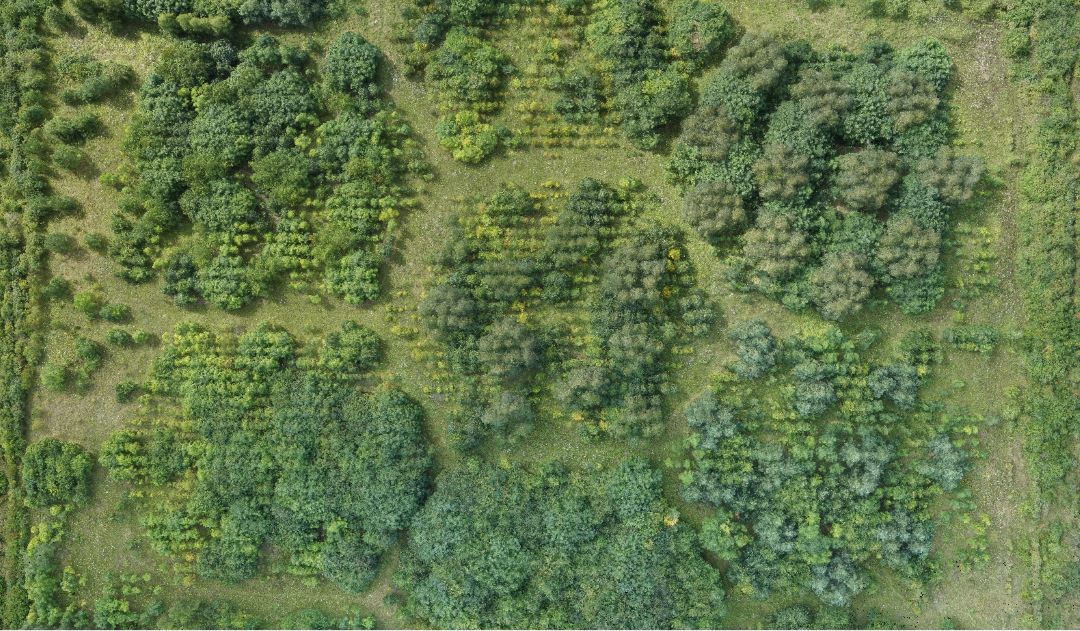
Design
BIOTREE-SPECIES
A diversity gradient was established by manipulating the number of species per plot. Each plot was subdivided in three subplots to accommodate a management treatment: (1) no management, (2) thinning according to close-to-nature forestry, and (3) thinning in plots in which 4 additional species adjusted to the site were planted. Trees were planted in monospecific cells of 8 m x 8 m. These cells were randomly distributed within a subplot, and this distribution was repeated in the two other subplots of the plot. Within a cell, the trees were planted on rows that were 2 m apart. The within-row distance between trees depends on the planted species. The subexperiment consists of two sites: Mehrsted (calcareous soil, 1-6 species per plot) and Kaltenborn (acidic soil, 1-4 species per plot).
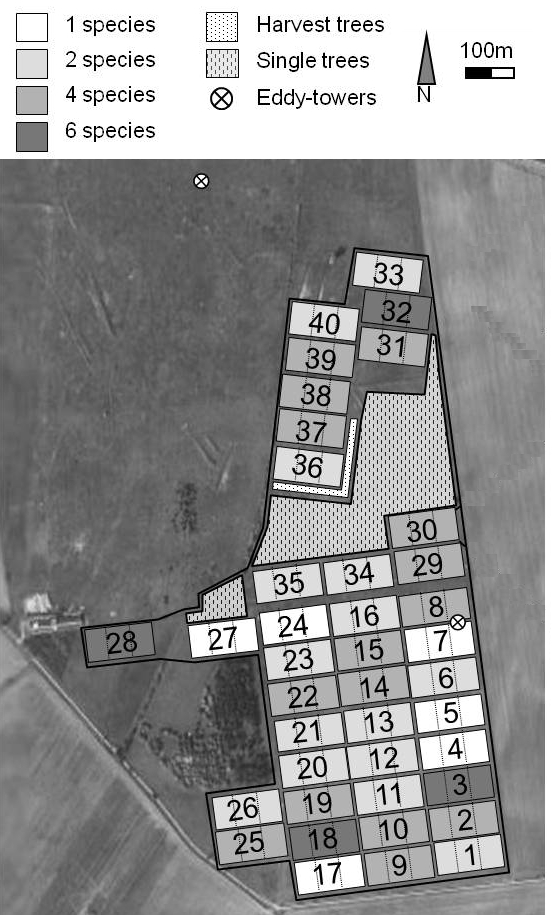
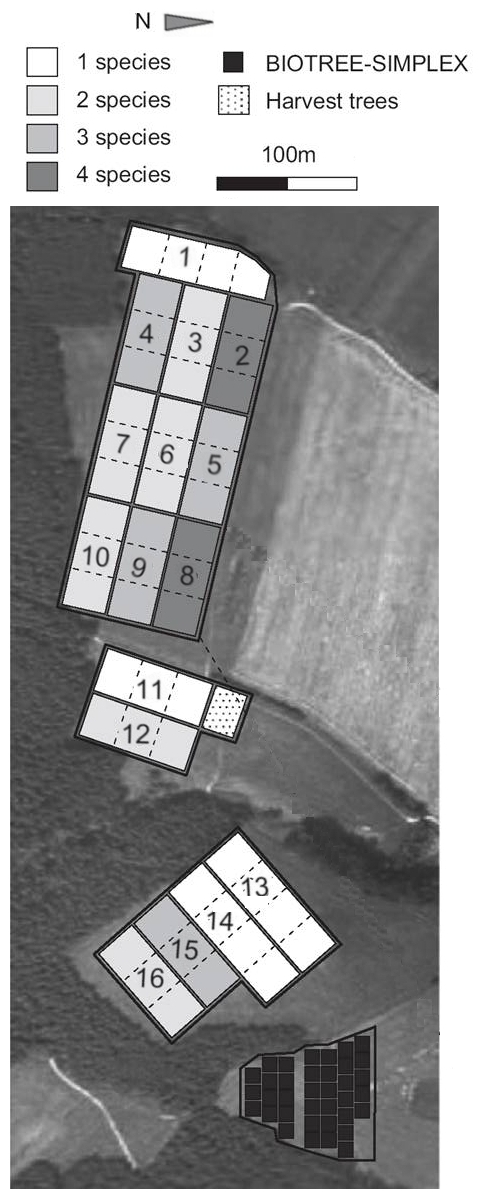
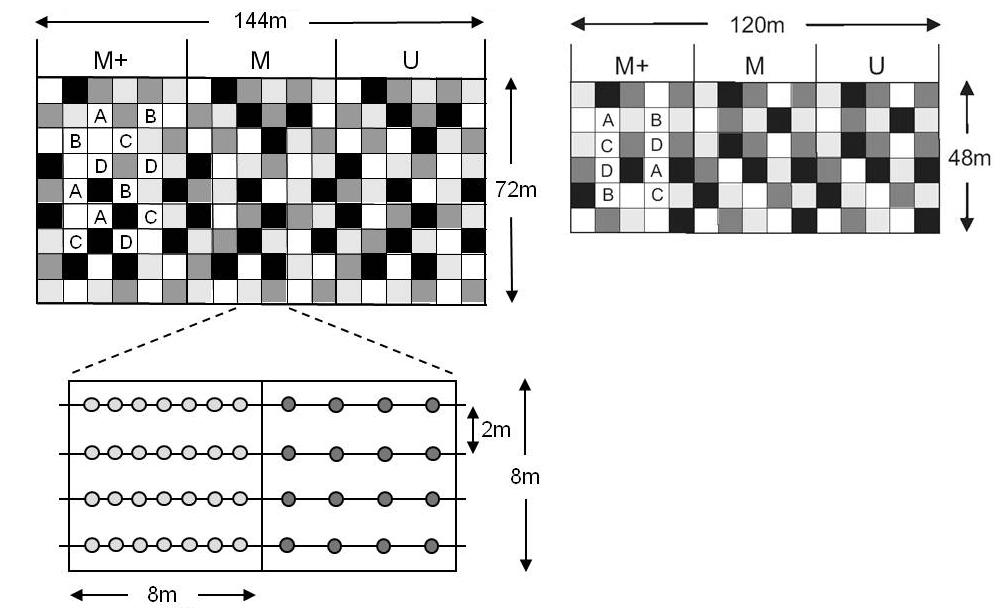
BIOTREE-FD
The BIOTREE-FD experiment has a gradient of tree functional diversity, at a constant number of tree species. All 25 plots contain 4 tree species, taken out of a total species pool of 16 species. The functional diversity of the plots - based on leaf type, light requirement, mean annual increment and litter C/N ratio - varies between very low and very high. Within each hexagonal plot, trees were planted in 44 monospecific round cells of 20 trees (planting distance 1 m x 2 m), i.e., 11 cells per tree species per plot.
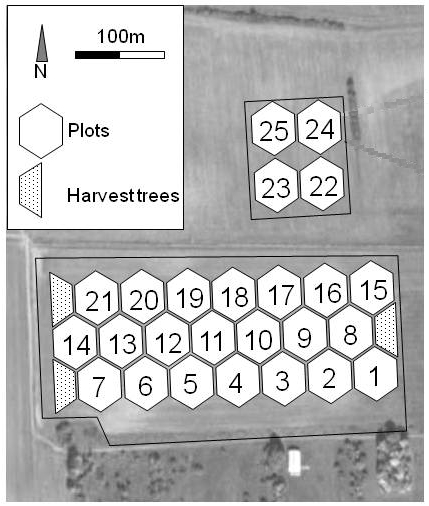
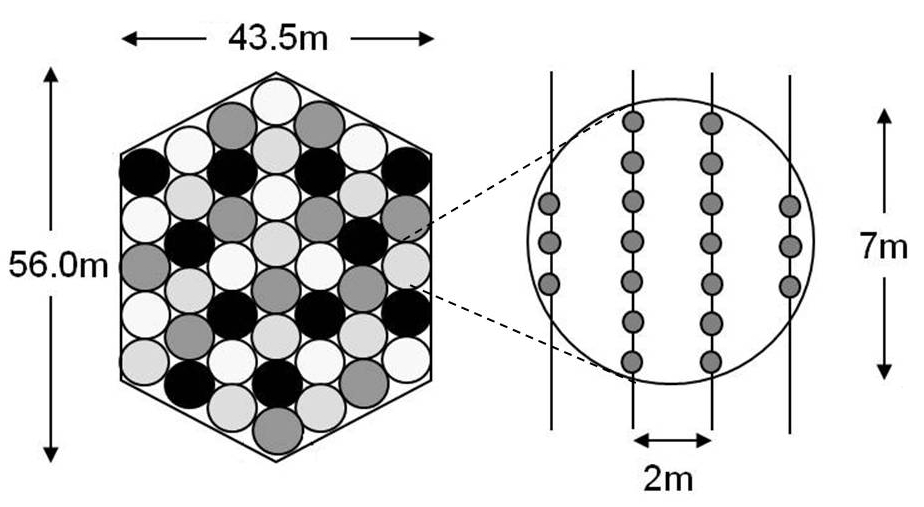
The plots and within-plot design of BIOTREE-FD in Bechstedt
BIOTREE-SIMPLEX
In the BIOTREE-SIMPLEX experiment, a gradient of tree species evenness has been established, by using different abundances of four species. There are 36 plots in total, with three different evenness levels and two different densities, replicated twice. The evenness levels are (1) dominant (70:10:10:10), (2) co-dominant (30:30:30:10), and (3) even (25:25:25:25), with all possible abundance combinations of the four species. Planting distances in the low density treatment are 2 x 1.5m (80 individuals per plot), and 1 x 1.5m in the high density treatment (150 individuals per plot).
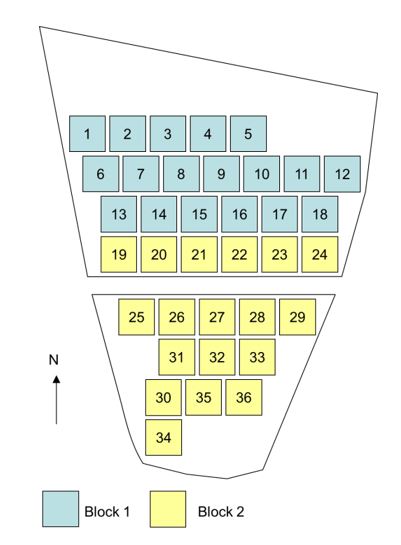
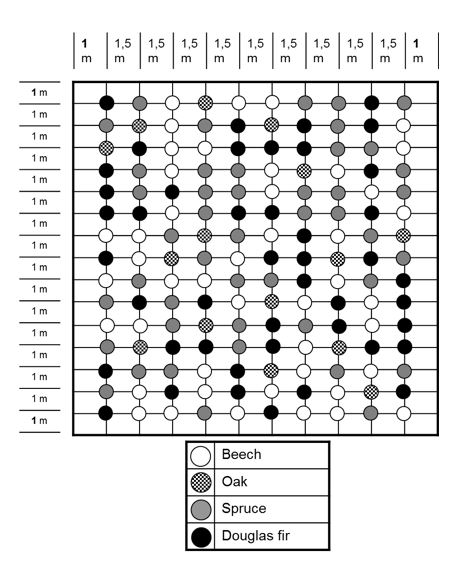
The plots and within-plot design of BIOTREE-SIMPLEX in Kaltenborn. An example of a high-density, co-dominant mixture is shown.
Site characteristics
| BIOTREE-SPECIES (Mehrstedt) | BIOTREE-SPECIES (Kaltenborn) | BIOTREE-FD (Bechstedt) | BIOTREE-SIMPLEX (Kaltenborn) | |
|---|---|---|---|---|
| Country | Germany | Germany | Germany | Germany |
| Biome | temperate | temperate | temperate | temperate |
| Latitude | 51.27298552 | 50.77867877 | 50.8971517 | 50.78027264 |
| Longitude | 10.65373559 | 10.22259501 | 11.08238333 | 10.23156905 |
| Soil type | Stagnic vertisols dominated by clay and silt on a limestone bedrock | Orthoeutric arenosols with loamy sand on a sandstone bedrock | Stagnic vertisols on a limestone bedrock | Orthoeutric arenosols with loamy sand on a sandstone bedrock |
| Former land use | grassland, then pasture | cropland till 1975, then grassland | pasture | pasture |
| Altitude | 293 m | 325 m | 400 m | 325 m |
| Design | patch-wise planting (8 m x 8 m), patches random within plot | patch-wise planting (8 m x 8 m), patches random within plot | patch-wise planting | stem-wise randomisation |
| Plot shape | rectangular | rectangular | hexagonal | rectangular |
| Plot size (m^2) | 10368 m² | 5952 m² | 2436 m² | 256 m² |
| Plant distance (m) | 1, 1.5, 2 (in row), 2 (between) | 1, 1.5, 2 (in rows), 2 (between) | 1 (in row), 2 (between) | 1 or 2 (in row), 1.5 (between) |
| Number of trees planted | 137 612 | 31 096 | 22 000 | 4 140 |
| Planting date | spring 2003 | spring 2004 | spring 2003 | spring 2004 |
| Diversity variables | species richness | species richness | functional diversity | species evenness |
| Diversity gradient | 1, 2, 4, 6 sp. | 1, 2, 3, 4 sp. | very low - very high | low, mid, high |
| Size species pool | 10 | 8 | 16 | 4 |
| Species pool | Acer pseudoplatanus Fagus sylvatica Larix decidua Pseudotsuga menziesii Quercus petraea Tilia cordata Acer platanoides Carpinus betulus Fraxinus excelsior Prunus avium |
Fagus sylvatica Picea abies Pseudotsuga menziesii Quercus petraea Abies alba Acer pseudoplatanus Fraxinus excelsior Sorbus aucuparia |
Acer campestre Acer platanoides Acer pseudoplatanus Betula pendula Carpinus betulus Fagus sylvatica Fraxinus excelsior Larix decidua Pinus sylvestris Populus tremula Prunus avium Quercus petraea Sorbus aucuparia Sorbus torminalis Tilia cordata Ulmus glabra |
Fagus sylvatica Picea abies Pseudotsuga menziesii Quercus petraea |
| Contact person | Michael Scherer-Lorenzen | Michael Scherer-Lorenzen | Michael Scherer-Lorenzen | Michael Scherer-Lorenzen |
| michael.scherer@biologie.uni-freiburg.de | michael.scherer@biologie.uni-freiburg.de | michael.scherer@biologie.uni-freiburg.de | michael.scherer@biologie.uni-freiburg.de |
Research
Studies will focus on the relationship between tree species richness, functional diversity or tree species evenness and soil properties, tree growth and mortality, herb layer diversity and composition, herbivory damage, and carbon sequestration. Regular inventories for height and diameter growth, crown sizes and mortality have been done every three years. Additional data sampling was done within the EU-projects BACCARA and FunDivEUROPE.
Extra information
Send an e-mail to the contact person or explore the publications that utilized data from this experiment.
PhD thesis
- Kovach, K 2021 Measurements of canopy properties to reveal biodiversity-ecosystem function relationships in tree diversity experiments using UAV remote sensing. PhD thesis, University of Freiburg
- Grossiord C 2014 Impact of tree species diversity on water and carbon relations in European forests. PhD thesis, University of Lorraine
- Müller S 2014 Architectural light foraging syndromes of juvenile temperate broadleaved trees. PhD thesis, University of Freiburg
- Hantsch L 2013 Tree diversity effects on species richness and infestation of foliar fungal pathogens in European tree diversity experiments. PhD thesis, Martin-Luther University Halle
- Morath S 2013 Effects of tree species diversity on insect herbivory. PhD thesis, Royal Holloway University of London
- Don A 2007 Carbon dynamics of young experimental afforestations in Thuringia. PhD thesis, Eberhard Karls University Tübingen
Research papers
- Augusto L, Borelle R, Boča A, Bon L, Orazio C, Arias-González A, Bakker MR, Gartzia-Bengoetxea H, Bernier AF, Cantero A, Cavender-Bares J, Correia AH, De Schrijver A, Diez-Casero JJ, Eisenhauer N, Fotelli MN, Gâteblé G, Godbold DL, Gomes-Caetano-Ferreira, Gundale MJ, Jactel H, Koricheva J, Larsson M, Laudicina VA, Legout A, Martín-García J, Mason WL, Meredieu C, Mereu S, Montgomery RA, Musch B, Muys B, Paillassa E, Paquette A, Parker JD, Parker WC, Ponette Q, Reynolds C, Rozados-Lorenzo MJ, Ruiz-Peinado R, Santesteban-Insausti X, Scherer-Lorenzen M, Silva-Pando FJ, Smolander A, Spyroglou G, Teixeira-Barcelos EB, Vanguelova EI, Verheyen K, Vesterdal L, Charru M 2025 Widespread slow growth of acquisitive tree species. Nature 640: 395–401 - doi: 10.1038/s41586-025-08692-x
- Blondeel H, Guillemot J, Martin‐StPaul N, Druel A, Bilodeau‐Gauthier S, Bauhus J, … Baeten L 2024 Tree diversity reduces variability in sapling survival under drought. Journal of Ecology 112(5): 1164-1180 - https://doi.org/10.1111/1365-2745.14294
- Luo S, Schmid B, Hector A, Scherer‐Lorenzen M, Verheyen K, Barsoum N, Bauhus J, Beyer F, Bruelheide H, Ferlian O, Godbold D, Hall JS, Hajek P, Huang Y, Hölscher D, Kreft H, Liu X, Messier C, Nock C, Paquette A, Parker JD, Parker WC, Paterno GB, Reich PB, Rewald B, Sandén H, Sinacore K, Stefanski A, Willams L, Eisenhauer N 2024 Mycorrhizal associations modify tree diversity− productivity relationships across experimental tree plantations. New Phytologist 243:1205-1219 - doi: 10.1111/nph.19889
- Vázquez-González C, Castagneyrol B, Muiruri EW, Barbaro L, Abdala-Roberts L, Barsoum N, Fründ J, Glynn C, Jactel H, McShea WJ, Mereu S, Mooney KA, Morillas L, Nock CA, Paquette A, Parker JD, Parker, WC, Roales J, Scherer-Lorenzen M, Schuldt A, Verheyen K, Weih M, Yang B, Koricheva J 2024 Tree diversity enhances predation by birds but not by arthropods across climate gradients. Ecology Letters (27): e14427 - https://doi.org/10.1111/ele.14427
- Zheng L, Barry KE, Guerrero-Ramírez NR, Craven D, Reich PB, Verheyen K, … Hautier Y 2024 Effects of plant diversity on productivity strengthen over time due to trait-dependent shifts in species overyielding. Nature communications 15(1): 2078 - https://doi.org/10.1038/s41467-024-46355-z
- Depauw L, De Lombaerde E, Dhiedt E, Blondeel H, Abdala-Roberts L, Auge H, Barsoum N, Bauhus J, Chu C, Damtew A, Eisenhauer N, V. Fagundes M, Ganade G, Gendreau-Berthiaume B, Godbold D, Gravel D, Guillemot J, Hajek P, Hector A, Hérault B, Jactel H, Koricheva J, Kreft H, Liu X, Mereu S, Messier C, Muys B, Nock CA, Paquette A, Parker JD, Parker WC, Paterno, GB, Perring MP, Ponette Q, Potvin C, Reich PB, Rewald B, Scherer-Lorenzen M, Schnabel F, Sousa-Silva R, Weih M, Clara Zemp D, Verheyen K, Baeten L 2024 Enhancing Tree Performance Through Species Mixing: Review of a Quarter-Century of TreeDivNet Experiments Reveals Research Gaps and Practical Insights. Current Forestry Reports - https://doi.org/10.1007/s40725-023-00208-y
- Desie E, Zuo J, Verheyen K, Djukic I, Van Meerbeek K, Auge H, Barsoum N, Baum C, Bruelheide H, Eisenhauer N, Feldhaar H, Ferlian O, Gravel D, Jactel H, Kappel Schmidt I, Kepfer-Rojas S, Meredieu C, Mereu S, Messier C, Morillas L, Nock C, Paquette A, Ponette Q, Reich PB, Roales J, Scherer-Lorenzen M, Seitz S, Schmidt A, Stefanski A, Trogisch S, van Halder I, Weih M, Williams LJ, Yang B, Muys B 2023 Disentangling drivers of litter decomposition in a multi-continent network of tree diversity experiments. Science of the Total Environment 857(3): 159717 - https://doi.org/10.1016/j.scitotenv.2022.159717
- FAO 2023 Towards more resilient and diverse planted forests. Unasylva (254)74: 2031/1. Rome. https://doi. org/10.4060/cc8584en
- Cesarz S, Craven D, Auge H, Bruelheide H, Castagneyrol B, Gutknecht J, Hector A, Jactel H, Koricheva J, Messier C, Muys B, Brien MJO, Paquette A, Ponette Q, Potvin C, Reich PB, Scherer-Lorenzen M, Smith AR, Verheyen K, Eisenhauer N 2022 Tree diversity effects on soil microbial biomass and respiration are context dependent across forest diversity experiments. Global Ecology and Biogeography 31:872-885 - https://doi.org/10.1111/geb.13461
- Shovon TA, Kang S, Scherer-Lorenzen M, Nock CA 2022 Changes in the direction of the diversity–productivity relationship over 15 years of stand development in a planted temperate forest. Journal of Ecology - https://doi.org/10.1111/1365-2745.13855
- Kwon T, Shibata H, Kepfer-Rojas S, Schmidt IK, Larsen KS, Beier C, Berg B, Verheyen K, Lamarque J-F, Hagedorn F, Eisenhauer N, Djukic I, TeaCompositionNetwork 2021 Effects of climate and atmospheric nitrogen deposition on early to mid-term stage litter decomposition across biomes. Frontiers in Forests and Global Change 4: 678480 - https://doi.org/10.3389/ffgc.2021.678480
- Serrano-León H, Nitschke R, Scherer-Lorenzen M, Forrester DI 2021 Intra-specific leaf trait variability of F. sylvatica, Q. petraea and P. abies in response to inter-specific competition and implications for forest functioning. Tree Physiology 42, 253-272 - https://doi.org/10.1093/treephys/tpab109
- Messier C, Bauhus J, Sousa-Silva R, Auge H, Baeten L, Barsoum N, Bruelheide H, Caldwell B, Cavender-Bares J, Dhiedt E, Eisenhauer N, Ganade G, Gravel D, Guillemot J, Hall JS, Hector A, Hérault B, Jactel H, Koricheva J, Kreft H, Mereu S, Muys B, Nock CA, Paquette A, Parker JD, Perring MP, Ponette Q, Potvin C, Reich PB, Scherer-Lorenzen M, Schnabel F, Verheyen K, Weih M, Wollni M, Zemp DC 2021 For the sake of resilience and multifunctionality, let’s diversify planted forests! Conservation Letters e12829 - https://doi.org/10.1111/conl.12829
- Matevski D, Schuldt A 2020 Tree species richness, tree identity and non-native tree proportion affect arboreal spider diversity, abundance and biomass. Forest Ecol Manag, 118775 - https://doi.org/10.1016/j.foreco.2020.118775
- Patoine G, Bruelheide H, Haase J, Nock C, Ohlmann N, Schwarz B, Scherer-Lorenzen M, Eisenhauer N, 2020 Tree litter functional diversity and nitrogen concentration enhance litter decomposition via changes in earthworm communities. Ecology and Evolution 10, 6752-6768 - https://doi.org/10.1002/ece3.6474
- Kambach S, Allan E, Bilodeau-Gauthier S, Coomes D A, Haase J, Jucker T, Kunstler G, Muller S, Nock C, Paquette A, van der Plas F, Ratcliffe S, Roger F, Ruiz-Benito P, Scherer-Lorenzen M, Auge H, Bouriaud O, Castagneyrol B, Dahlgren J, Gamfeldt L, Jactel H, Kandler G, Koricheva J, Lehtonen A, Muys B, Ponette Q, Setiawan N, Van de Peer T, Verheyen K, Zavala M A, Bruelheid H 2019 How do trees respond to species mixing in experimental compared to observational studies? Ecology and Evolution 9: 11254-11265 - https://doi.org/10.1002/ece3.5627
- Grossman JJ, Vanhellemont M, Barsoum N, Bauhus J, Bruelheide H, Castagneyrol B, Cavender-Bares J, Eisenhauer N, Ferlian O, Gravel D, Hector A, Jactel H, Kreft H, Mereu S, Messier C, Muys B, Nock C, Paquette A, Parker J, Perring MP, Ponette Q, Reich PB, Schuldt A, Staab M, Weih M, Zemp DC, Scherer-Lorenzen M, Verheyen K 2018 Synthesis and future research directions linking tree diversity to growth, survival, and damage in a global network of tree diversity experiments. Environmental and Experimental Botany 152: 68-89 - doi: 10.1016/j.envexpbot.2017.12.015
- Koricheva J, Hayes D 2018 The relative importance of plant intraspecific diversity in structuring arthropod communities: A meta-analysis. Functional Ecology 32: 1704-1717 - doi: 10.1111/1365-2435.13062
- Alberti G, Nock C, Fornasier F, Scherer-Lorenzen M, De Nobili M, Peresotti A, Hönig L, Bruelheide H, Bauhus J 2017 Tree functional diversity influences belowground ecosystem functioning. Applied Soil Ecology 120: 160-168 - doi: 10.1016/j.apsoil.2017.07.038
- Patoine G, Thakur MP, Friese J, Nock C, Hönig L, Haase J, Scherer-Lorenzen M, Eisenhauer N 2017 Plant litter functional diversity effects on litter mass loss depend on the macro-detritivore community. Pedobiologia - Journal of Soil Ecology 65: 29-42 - doi: 10.1016/j.pedobi.2017.07.003
- Annighöfer P, Ameztegui A, Ammer C, Balandier P, Bartzsch N, Bolte A, Coll L, Collet C, Ewald J, Frischbier N, Gebereyesus T, Haase J, Hamm T, Hirschfelder B, Huth F, Kändler G, Kahl A, Kawaletz H, Kuehne C, Lacointe A, Lin N, Löf M, Malagoli P, Marquier A, Müller, Promberger S, Provendier D, Röhle H, Sathornkich J, Schall P, Scherer-Lorenzen M, Schröder J, Seele C, Weidig J, Wirth C, Wolf H, Wollmerstädt J, Mund M 2016 Species-specific and generic biomass equations for seedlings and saplings of European tree species. European Journal of Forest Research 135: 313-329 - doi: 10.1007/s10342-016-0937-z
- Verheyen K, Vanhellemont M, Auge H, Baeten L, Baraloto C, Barsoum N, Bilodeau-Gauthier S, Bruelheide H, Castagneyrol B, Godbold D, Haase J, Hector A, Jactel H, Koricheva J, Loreau M, Mereu S, Messier C, Muys B, Nolet P, Paquette A, Parker J, Perring M, Ponette Q, Potvin C, Reich P, Smith A, Weih M, Scherer-Lorenzen M 2016 Contributions of a global network of tree diversity experiments to sustainable forest plantations. Ambio 45: 29-41 - doi: 10.1007/s13280-015-0685-1
- Ampoorter E, Baeten L, Vanhellemont M, Bruelheide H, Scherer-Lorenzen M, Baasch A, Erfmeier A, Hock M, Verheyen K 2015 Disentangling tree species identity and richness effects on the herb layer: first results from a German tree diversity experiment. Journal of Vegetation Science 26: 742-755 - doi: 10.1111/jvs.12281
- Domisch T, Finér L, Dawud SM, Vesterdal L, Raulund-Rasmussen K 2015 Does species richness affect fine root biomass and production in young forest plantations? Oecologia 177: 581-594 - doi: 10.1007/s00442-014-3107-3
- Haase J, Castagneyrol B, Cornelissen JHC, Ghazoul J, Kattge J, Koricheva J, Scherer-Lorenzen M, Morath S, Jactel H 2015 Contrasting effects of tree diversity on young tree growth and resistance to insect herbivores across three biodiversity experiments. Oikos 124: 1674-1685 - doi: 10.1111/oik.02090
- Schwarz B, Dietrich C, Cesarz S, Scherer-Lorenzen M, Auge H, Schulz E, Eisenhauer N 2015 Non-significant tree diversity but significant identity effects on earthworm communities in three tree diversity experiments. European Journal of Soil Biology 67: 17-26 - doi: 0.1016/j.ejsobi.2015.01.001
- Paine CET, Amissah L, Auge H, Baraloto C, Baruffol M, Bourland N, Bruelheide H, Daïnou K, de Gouvenain RC, Doucet J-L, Doust S, Fine PVA, Fortunel C, Haase J, Holl KD, Jactel H, Li X, Kitajima K, Koricheva J, Martínez-Garza C, Messier C, Paquette A, Philipson C, Piotto D, Poorter L, Posada JM, Potvin C, Rainio K, Russo SE, Ruiz-Jaen M, Scherer-Lorenzen M, Webb CO, Wright SJ, Zahawi RA, Hector A 2015 Globally, functional traits are weak predictors of juvenile tree growth, and we do not know why. Journal of Ecology 103: 978-989 - doi: 10.1111/1365-2745.12401
- Grossiord C, Gessler A, Granier A, Berger S, Bréchet C, Hentschel R, Hommel R, Scherer-Lorenzen M, Bonal D 2014 Impact of interspecific interactions on the soil water uptake depth in a young temperate mixed species plantation. Journal of Hydrology 519: 3511-3519 - doi: 10.1016/j.jhydrol.2014.11.011
- Hantsch L, Braun U, Haase J, Purschke O, Scherer-Lorenzen M, Bruelheide H 2014 No plant functional diversity effects on foliar fungal pathogens in experimental tree communities. Fungal Diversity 66: 139-151 - doi: 10.1007/s13225-013-0273-2
- Pollastrini M, Holland V, Brüggemann W, Koricheva J, Jussila I, Scherer-Lorenzen M, Berger S, Bussotti F 2014 Interactions and competition processes among tree species in young experimental mixed forests, assessed with chlorophyll fluorescence and leaf morphology. Plant Biology 16: 323-331 - doi:10.1111/plb.12068
- Grossiord C, Granier A, Gessler A, Scherer-Lorenzen M, Pollastrini M, Bonal D 2013 Application of Loreau & Hector’s (2001) partitioning method to complex functional traits. Methods in Ecology and Evolution 4: 954-960 - doi: 10.1111/2041-210X.12090
- Hantsch L, Braun U, Scherer-Lorenzen M, Bruelheide H 2013 Species richness and species identity effects on occurrence of foliar fungal pathogens in a tree diversity experiment. Ecosphere 4: 81 - doi: 10.1890/ES13-00103.1
- Lei P, Scherer-Lorenzen M, Bauhus J 2012 Belowground facilitation and competition in young tree species mixtures. Forest Ecology and Management 265: 191-200 - doi: 10.1016/j.foreco.2011.10.033
- Lei P, Scherer-Lorenzen M, Bauhus J 2012 The effect of tree species diversity on fine-root production in a young temperate forest. Oecologia 169: 1105-1115 - doi: 10.1007/s00442-012-2259-2
- Lei P, Bauhus J 2010 Use of near-infrared reflectance spectroscopy to predict species composition in tree fine-root mixtures. Plant and Soil 333: 93-103 - doi: 10.1007/s11104-010-0325-2
- Don A, Rebmann C, Kolle O, Scherer-Lorenzen M, Schulze E-D 2009 Impact of afforestation-associated management changes on the carbon balance of grassland. Global Change Biology 15: 1990-2002 - doi: 10.1111/j.1365-2486.2009.01873.x
- Scherer-Lorenzen M, Schulze E-D, Don A, Schumacher J, Weller E 2007 Exploring the functional significance of forest diversity: A new long-term experiment with temperate tree species (BIOTREE). Perspectives in Plant Ecology, Evolution and Systematics 9: 53-70 - doi: 10.1016/j.ppees.2007.08.002
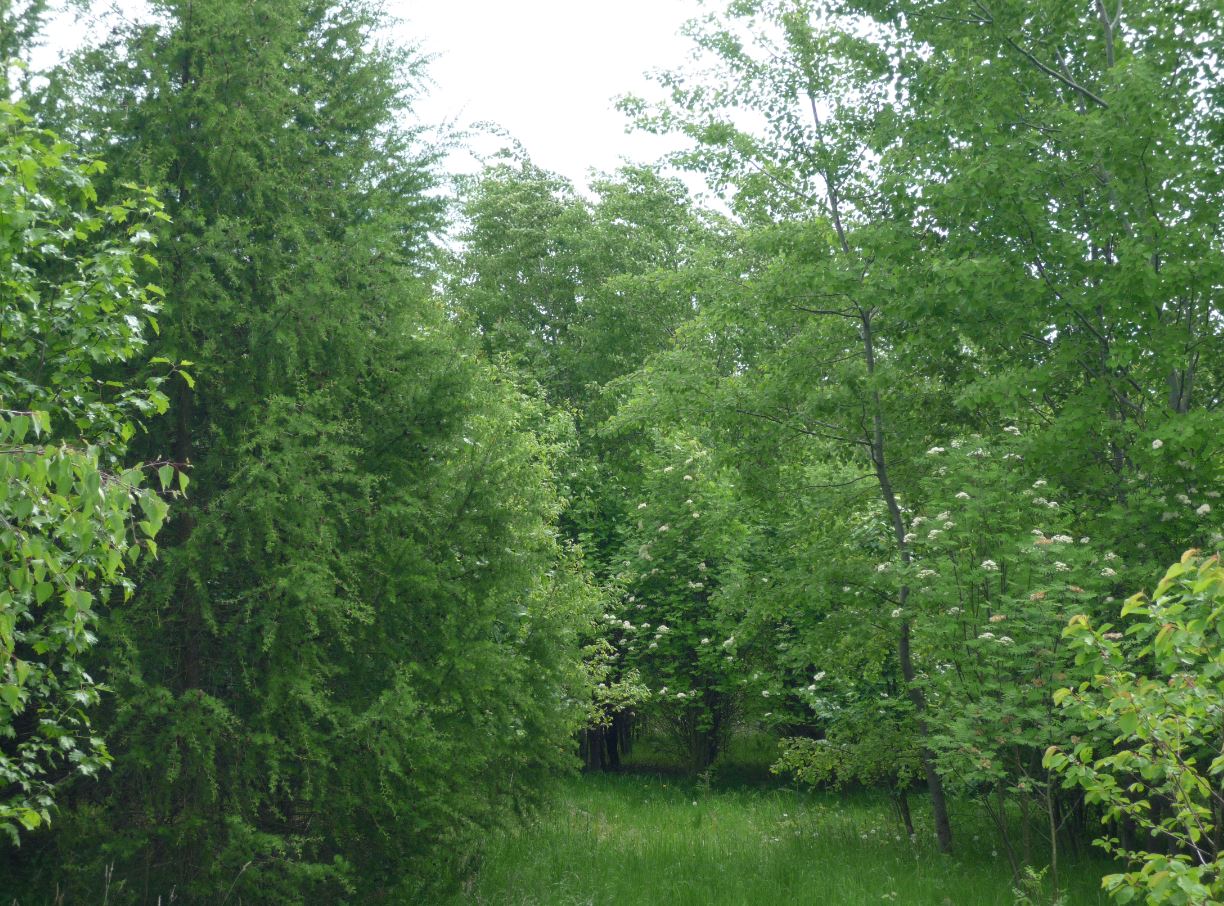
BIOTREE-Species in Kaltenborn (November 2024) and mixed plots at the BIOTREE-FD experiment in Bechstedt (May 2014)